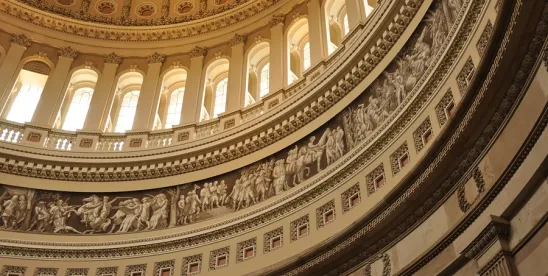Fusion energy continues to build support among U.S. policymakers. On 24 September 2020, the U.S. House of Representatives approved a program for fusion energy research and commercialization as part of a legislative package covering a wide range of energy topics.1 On fusion energy, Reps. Conor Lamb (D-PA) and Lori Trahan (D-MA) authored an amendment authorizing the U.S. Department of Energy (DOE) to pursue a range of programmatic goals, including a public-private partnership where federal funds will be available for private companies developing fusion energy solutions.2
Now attention turns towards the U.S. Senate, which has not set a date for considering a similar energy package. With scheduling constraints imposed by the upcoming 2020 election, it is not clear when the Senate might consider energy legislation and when, or if, this legislation will eventually be presented to the President for his approval to become federal law. But approval of these fusion provisions by the House of Representatives, especially the public-private partnership, signals that support for the commercial fusion energy industry is increasing in the U.S. Congress.
This article will outline the scope of the fusion energy provisions of the legislation, briefly analyze the provisions standing up the public-private partnership program, and outline next steps for codifying this fusion energy legislation as federal law.
Fusion Energy Provisions
In addition to the public-private partnership program, the Lamb-Trahan amendment on fusion energy contains provisions addressing the following topics:
-
Authorizing a program for the DOE’s Fusion Energy Sciences Program within the DOE’s Office of Science for continuing fusion energy science research, enabling technology for a cost-competitive fusion power plant, and establishing a competitive fusion power industry in the United States;
-
Directing the Office of Science to support inertial fusion energy for energy applications, fusion reactor system design, and general plasma science;
-
Mandating the DOE’s support for a portfolio of alternative fusion energy concepts and designs, including advanced stellarator concepts, non-tokamak confinement configurations, and magnetized target fusion energy, as well as enabling technologies like high-temperature superconductors, liquid metal for the inner wall of the plasma encasing device, advanced blankets for heat management and fuel breeding, and advanced scientific computing;
-
Continuing and expanding support for the DOE’s Innovation Network for Fusion Energy (the popular INFUSE) Program across the DOE’s national laboratory complex;
-
Approving the United States’ continued participation in the international ITER fusion collaboration and requiring a report to Congress assessing ITER’s most recent project schedule; and
-
Requesting a report on opportunities for the Office of Science to coordinate activities with DOE’s Office of Nuclear Energy.
Public-Private Partnership
The Lamb-Trahan amendment also would establish a “Milestone-Based Development Program,” which would create public-private partnerships where federal funds will be available to private fusion energy companies through milestone-based funding. Similar to a program that the National Aeronautics and Space Administration (NASA) used to support growth of a private space transport industry,3 the program would have a goal of supporting the development of a U.S.-based fusion power industry and construction of a full-scale fusion system within 10 years.
Under the program, any entity (not only U.S.-based or U.S.-owned companies) with the necessary resources and expertise can enter into an agreement with the DOE that would provide funding for private entities that meet agreed-upon technical or development milestones. Applicants will be evaluated on scientific, technical, and business criteria through a peer-review process. The DOE’s panel of reviewers would include people with expertise in the private sector, the investment community, and experts in fusion and plasma physics science and engineering.
Until the milestone is reached, the private entity will bear the costs and expenses of developing the project, and the DOE may cancel the agreement if the private entity does not meet its milestones. As with the selection of program participants, the DOE must consult with reviewers to confirm whether a developer has completed its milestones, including reviewers from the private sector.
As approved by the House, the bill would authorize the substantial funds for the milestone program:
| Fiscal Year | Authorized Appropriations |
| 2021 | US$45,000,000 |
| 2022 | US$110,000,000 |
| 2023 | US$140,000,000 |
| 2024 | US$110,000,000 |
| 2025 | US$45,000,000 |
To keep Congress apprised of the program’s progress, the legislation would require the DOE to submit a report annually on the program’s partnerships to the House Committee on Science, Space, and Technology and the Senate Committee on Energy and Natural Resources. And within four years of the DOE establishing three milestones under the program, the bill would direct the DOE to contract with the National Academy of Sciences to review the milestone funding program for the benefits and drawbacks of the milestone funding approach compared to the DOE’s other funding structures and to highlight the lessons learned from program operations.
Next Steps
As indicated above, the House measure, including its fusion energy provisions, must await a companion bill from the Senate. Given other legislative priorities, like a pending nomination to the U.S. Supreme Court, as well as the upcoming U.S. election on 3 November 2020, it may be difficult for the Senate to schedule comprehensive energy legislation. The U.S. Senate Appropriations Committee indicated support for development of a commercial fusion energy industry in the United States last year.4 Likewise, the House Appropriations Committee initially offered support for the public-private partnership approach last year.5 Despite this bicameral support, there may not be a vehicle for the House and Senate to agree on fusion energy legislation until at least after the November election.
Nevertheless, the Lamb-Trahan amendment is a positive sign for federal support for private efforts to commercialize fusion energy. The program also received wide support from private industry when the DOE solicited comments on a similar cost-share program in April 2020.6 As Rep. Trahan noted in her remarks in support of the program, the public-private partnerships would help “make fusion energy a reality by building full-scale demonstration facilities—and creating new companies and more jobs” in the United States.7 Stakeholders are waiting for publication of a DOE analysis of this cost-share approach, which could be released at any time.8 So there is reason for optimism that the U.S. government will eventually enact a milestone-based funding program like that proposed in the Lamb-Trahan amendment.
1Expanding Access to Sustainable Energy Act of 2019, H.R. 4447, 116th Cong. (2020), https://www.congress.gov/bill/116th-congress/house-bill/4447?q=%7B%22search%22%3A%5B%22hr4447%22%5D%7D&r=1&s=1.
2Amendment to Rules Committee Print 116-63, https://amendments-rules.house.gov/amendments/D_Fusion_xml918201343424342.pdf.
3NASA, Commercial Orbital Transport Services: A New Era in Spaceflight (2014), https://www.nasa.gov/sites/default/files/files/SP-2014-617.pdf.
4S. Rpt. No. 116-102 at 116 (2019), https://www.appropriations.senate.gov/imo/media/doc/FY2020%20Energy%20and%20Water%20Development%20Appropriations%20Act,%20Report%20116-1021.pdf.
5H. Rpt. No. 116-83 at 112 (2019), https://www.congress.gov/116/crpt/hrpt83/CRPT-116hrpt83.pdf.
6Cost-Sharing Partnerships with the Private Sector in Fusion Energy, 85 Fed. Reg. 21,842 (Apr. 20, 2020). Comments filed in response to the DOE’s solicitation for input are available at https://www.regulations.gov/docket?D=DOE-HQ-2020-0021.
7Statement of Rep. Trahan, 166 Cong. Rec. H4911 (Sept. 24, 2020).
8Further Consolidated Appropriations Act, 2020, H.R. 1865, 116th Cong., Pub. L. No. 116-94 at 467 (2020), https://www.govinfo.gov/content/pkg/CPRT-116HPRT38679/pdf/CPRT-116HPRT38679.pdf (directing the DOE to produce a plan for a fusion energy cost-share program, including program objectives, eligibility requirements, and a funding profile for future years).




 />i
/>i

